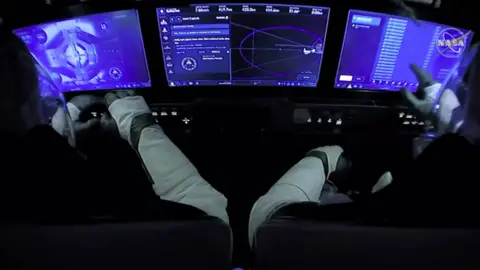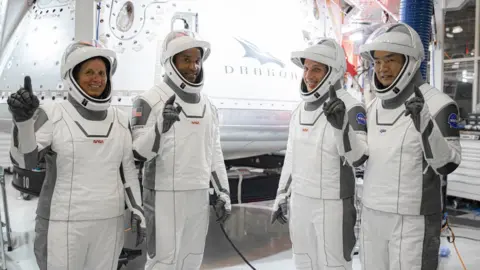What is the SpaceX Crew Dragon?
 NASA
NASAElon Musk's SpaceX has built the Crew Dragon primarily to carry astronauts to the International Space Station. It was developed as part of Nasa's plan to hand over space station flights to American companies, after years of relying on Russian launches. Here's our guide to the vehicle.
Elon Musk says human spaceflight had always been the fundamental goal for his pioneering company SpaceX.
The entrepreneur achieved that ambition on Saturday 30 May 2020, when the Crew Dragon spacecraft carried Nasa astronauts Doug Hurley and Bob Behnken into orbit for a rendezvous with the space station, or ISS. It was the first crewed vehicle to fly from US soil since the retirement of the shuttle in 2011.
When the shuttle programme ended, Nasa had no immediate replacement vehicle. This left the space agency reliant on Russia to fly American astronauts to the ISS. In the meantime, however, SpaceX and Boeing worked on developing vehicles to take over that job.
Crew Dragon is now making routine visits to the orbiting outpost and, as of September 2021, is also being used for fully private missions that carry "amateur astronauts" to orbit.
Musk's vehicle evolved from an earlier spacecraft, called Dragon 1, which has launched 20 times on missions to deliver cargo to the ISS.

An overview of Crew Dragon
In May 2014, Musk unveiled the seven-seat Crew Dragon concept during an event at SpaceX's headquarters in Hawthorne, California.
It's a capsule design - like the Apollo command modules that carried astronauts to the Moon.
From launch up until shortly before re-entry, the capsule is attached to a section called the trunk, which has solar panels, heat-removal radiators, space for cargo, and fins to provide stability during emergency aborts. Together, the capsule and trunk stand around 8.1m (26.7ft) tall, with a diameter of 4m (13ft).
The Crew Dragon is equipped with 16 Draco thrusters that manoeuvre the vehicle in orbit. Each Draco is capable of producing 90 pounds of force in the vacuum of space.
If anything goes wrong during lift-off, the capsule has a launch escape system (LES) consisting of eight SuperDraco engines that each produce 16,000 pounds of force. The LES quickly separates Crew Dragon from its rocket.
 Spacex
SpacexInside the spacecraft
SpaceX engineer John Federspiel, says the company had wanted to make Crew Dragon "feel like a 21st Century spaceship".
He explains: "Probably one of the biggest features of Dragon are the touchscreens on the inside. We designed them not just to be very functional, but with a user experience in mind."
The three large touchscreen displays that allow the commander and pilot to monitor and control the spacecraft are a world away from the analogue buttons and dials in the cockpits of previous vehicles such as the space shuttle.
As the first humans assigned to fly on Crew Dragon, Hurley and Behnken worked closely with SpaceX to get the capsule ready for its historic launch in May 2020. The crew members - who had both previously flown on the shuttle - provided vital input.
 NASA
NASAHurley admits the touchscreens took a bit of getting used to.
"As far as actual physical feedback, you certainly don't get that from the touchscreen," he says.
"But what you do get is an indication of where you touched." That indication is a "return flash" on the screen that lets the astronaut know if the vehicle correctly recognised their input.
For scenarios where astronauts might need to assume manual control of the normally autonomous craft, such as finishing off a docking sequence with the space station, the touchscreen controls are "much more than adequate", Hurley adds.
Behnken explains: "It just might not be the same thing you'd want to use if you were suited up and trying to fly an entry or descent, for example, like we could do with the space shuttle."
 SpaceX
SpaceX'A suit-seat system'
The space suits worn by astronauts have been one of the bigger talking points about Crew Dragon. The sleek, customised outfits contrast with previous designs. But their main purpose remains the same: to protect crew members from depressurisation, where air is lost from the capsule.
"The suit is really one part of the bigger Dragon system... we think of it as a suit-seat system," says Chris Trigg, space suits and crew equipment manager at SpaceX.
Crew Dragon has three different seat sizes, with foam that's moulded around the astronaut's body to make the journey to and from space as comfortable as possible.
When the astronaut gets ready to strap in, they plug an "umbilical" line from their seat into a port on the right thigh of their space suit. The umbilical provides the suit with life support systems, including air and electrical connections.
 SpaceX
SpaceXGetting to orbit
The Crew Dragon lifts off from Florida's Kennedy Space Center on a version of SpaceX's Falcon 9 rocket that's been adapted for astronauts.
In the event of an emergency on the pad or during the climb to orbit, the launch escape system will fire to propel the capsule and its crew away from the rocket. Parachutes are then deployed to bring the astronauts down safely.
Commenting on the LES, Doug Hurley says: "That perspective for me is huge compared to shuttle, where there were what we call 'black zones'... scenarios where it didn't really matter if you had the right combination of failures, you were likely not going to survive."
Hurley adds that the capsule design is safer than a winged vehicle under most circumstances.
Crew Dragon is also designed to be "two-fault tolerant". This means that any two things can fail, such as a flight computer and a thruster, and the spacecraft can still bring the crew home safely.
During missions to the ISS, the SpaceX vehicle docks with the orbiting outpost autonomously - that is, without having to be guided in by a human. Jessica Jensen, director of Starship mission hardware and operation at SpaceX, says: "We have GPS sensors on Dragon, but also cameras and imaging sensors such as Lidar (laser ranging) on the nosecone as it's approaching the space station.
 NASA / EPA
NASA / EPA"All these sensors are feeding data back to our flight computer to say: 'Hey, how far away am I from the space station? What's my relative velocity to the space station?'"
The flight computer then uses algorithms that determine - based on this information - how to fire the thrusters to most effectively get to the docking target.
The vehicle's lifetime in orbit is limited to a few months because of its solar panels, which degrade in the harsh environment of space.

Leaving for home
When astronauts are ready to return home from the space station, Crew Dragon first undocks and then performs a de-orbit burn with its thrusters.
The vehicle's heat shield, located at its base, must survive temperatures hotter than the surface of the Sun as the craft screams through the atmosphere at up to 25 times the speed of sound.
The material used in the heat shield is ablative: it slowly burns away at high temperatures to carry away much of the extreme heat.
There's a minor chance that the spacecraft's asymmetric design - driven by the placement of its emergency escape system - could cause it to roll too much. Elon Musk has said that the issue, known as roll instability, has been extensively studied, but that it still worries him.
"I think there's an argument that the return is more dangerous in some ways than the ascent," Musk says.
Then, after the fiery re-entry phase, the spacecraft needs to deploy four parachutes to slow its descent.
 NASA/Bill Ingalls
NASA/Bill IngallsFinally, the Crew Dragon splashes down in the Atlantic Ocean, 450km off the coast of Florida, where recovery ships will take the astronauts to safety and retrieve the capsule.
The spacecraft can then be refurbished. Nasa has agreed to let astronauts fly on re-used Crew Dragons - and Falcon 9 boosters - as soon as SpaceX completes its third launch to the ISS with humans.
Follow Paul on Twitter.
